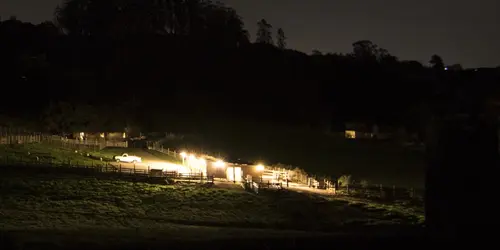Shaun Liddy
TPF Noob!
- Joined
- Nov 5, 2015
- Messages
- 19
- Reaction score
- 1
- Can others edit my Photos
- Photos NOT OK to edit
I recently picked up a Tokina 11-20 2.8 to use on my 7d Mii. I have been trying to hone in on my night shooting technique with it and ran it through a test last night.
On a tripod, varying shutter, ISO and aperture to produce images of equal light (as much as I could) and see what happens.
Below are 5 shots taken in raw, cropped and saved as JPG's. These were in no way meant to be anything more than shots to gain a better understanding of how my equipment responds and to gain an understanding from others as to how I might be able to over come some of these short comings.
Noise definitely presents itself when increasing the ISO, 800 is very noisy in the sky and other places compared to 100. I figured this was going to be the case.
But I also notice that the lights in the distance get much more of a star effect with the smaller aperture. I did a little homework on this and found that the smaller apertures can change the incoming light post aperture / pre sensor similarly to how a maglight focuses/spreads the light from the bulb when adjusted, IE it radiates a cone vs beam. I was surprised how much additional staring showed at fstop 8 vs 2.8. It is noticeably increasing from fstop 2.8/3/5/8.
I feel shooting with the longer exposure/lower ISO creates a better result (regards to ISO related noise) and will continue to keep ISO as low as possible in these very dark shots, but I'd like to be able to have some control of DOF for different subjects with out it resulting in the star effect with the lights.
Is there a filter that can help here? Or would that not be of help due to the lens optics and the way the light expands after it passes through the aperture?
At any rate, last night was a good lesson for myself.
4K9A2104
ISO – 100
FSTOP – 5
SHUTTER – 30
4K9A2113
ISO – 100
FSTOP – 3.5
SHUTTER – 20
4K9A2120
ISO – 100
FSTOP – 2.8
SHUTTER – 10
4K9A2123
ISO – 800
FSTOP – 2.8
SHUTTER – 1.3
4K9A2128
ISO – 640
FSTOP – 8
SHUTTER – 13
On a tripod, varying shutter, ISO and aperture to produce images of equal light (as much as I could) and see what happens.
Below are 5 shots taken in raw, cropped and saved as JPG's. These were in no way meant to be anything more than shots to gain a better understanding of how my equipment responds and to gain an understanding from others as to how I might be able to over come some of these short comings.
Noise definitely presents itself when increasing the ISO, 800 is very noisy in the sky and other places compared to 100. I figured this was going to be the case.
But I also notice that the lights in the distance get much more of a star effect with the smaller aperture. I did a little homework on this and found that the smaller apertures can change the incoming light post aperture / pre sensor similarly to how a maglight focuses/spreads the light from the bulb when adjusted, IE it radiates a cone vs beam. I was surprised how much additional staring showed at fstop 8 vs 2.8. It is noticeably increasing from fstop 2.8/3/5/8.
I feel shooting with the longer exposure/lower ISO creates a better result (regards to ISO related noise) and will continue to keep ISO as low as possible in these very dark shots, but I'd like to be able to have some control of DOF for different subjects with out it resulting in the star effect with the lights.
Is there a filter that can help here? Or would that not be of help due to the lens optics and the way the light expands after it passes through the aperture?
At any rate, last night was a good lesson for myself.
4K9A2104
ISO – 100
FSTOP – 5
SHUTTER – 30
4K9A2113
ISO – 100
FSTOP – 3.5
SHUTTER – 20
4K9A2120
ISO – 100
FSTOP – 2.8
SHUTTER – 10
4K9A2123
ISO – 800
FSTOP – 2.8
SHUTTER – 1.3
4K9A2128
ISO – 640
FSTOP – 8
SHUTTER – 13







![[No title]](/data/xfmg/thumbnail/37/37118-b2220638658eaeed2b9256c9a8fd0cf0.jpg?1734169832)


![[No title]](/data/xfmg/thumbnail/37/37120-1d477daab99b292a0c740b50f1c96d53.jpg?1734169832)






![[No title]](/data/xfmg/thumbnail/37/37117-26c892e756b53ed0359fa90b7ebd99c9.jpg?1734169832)
